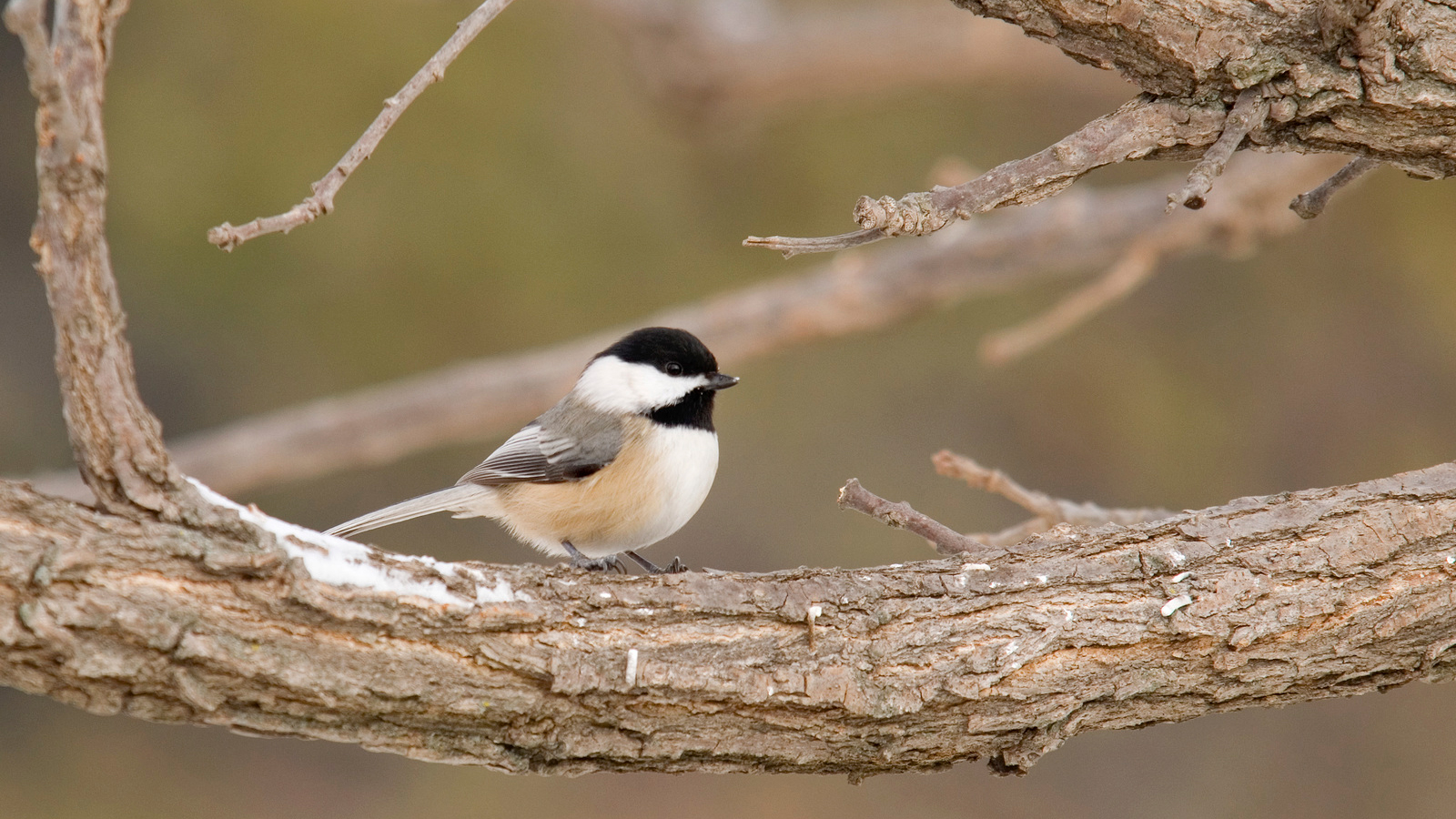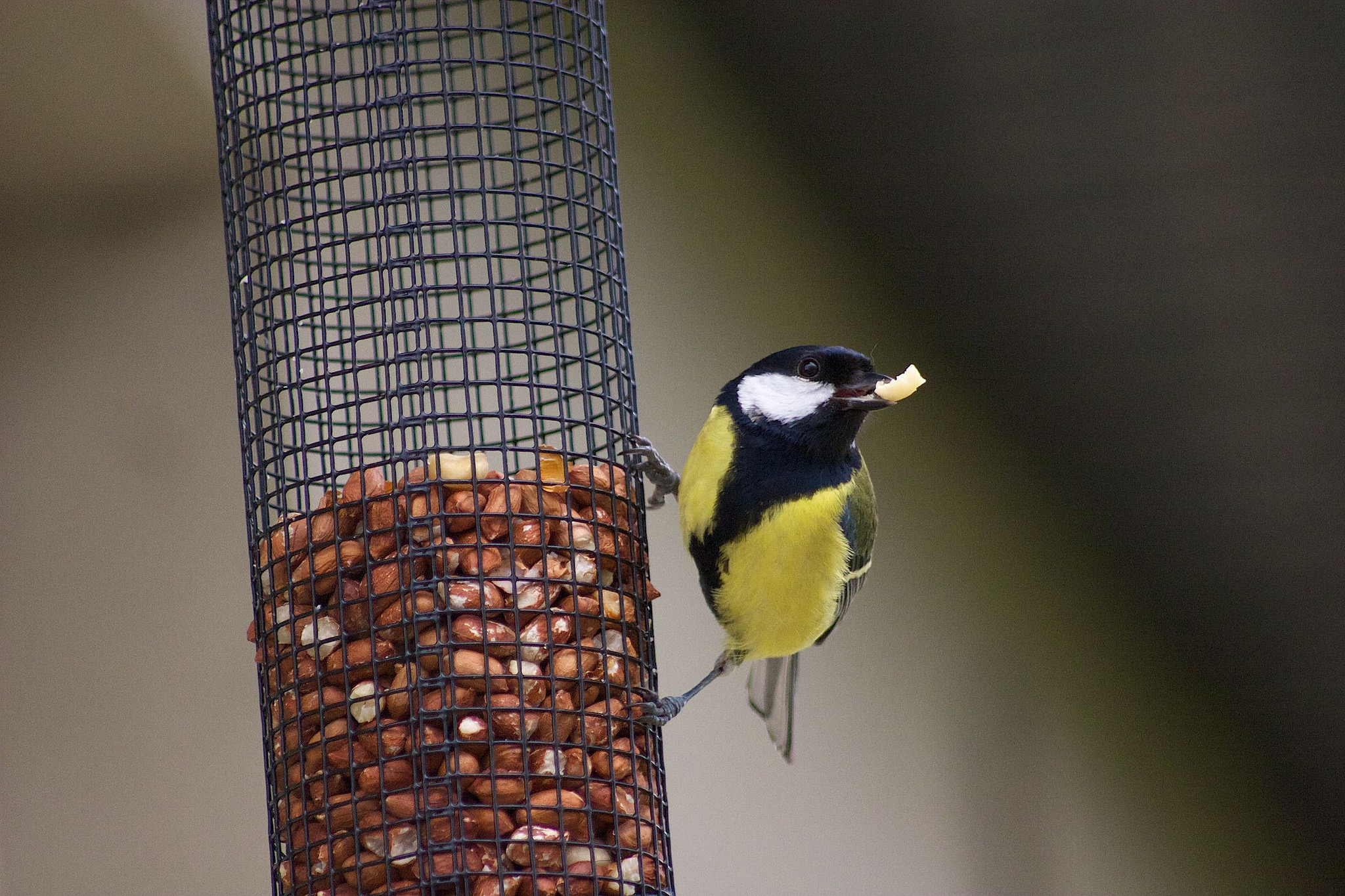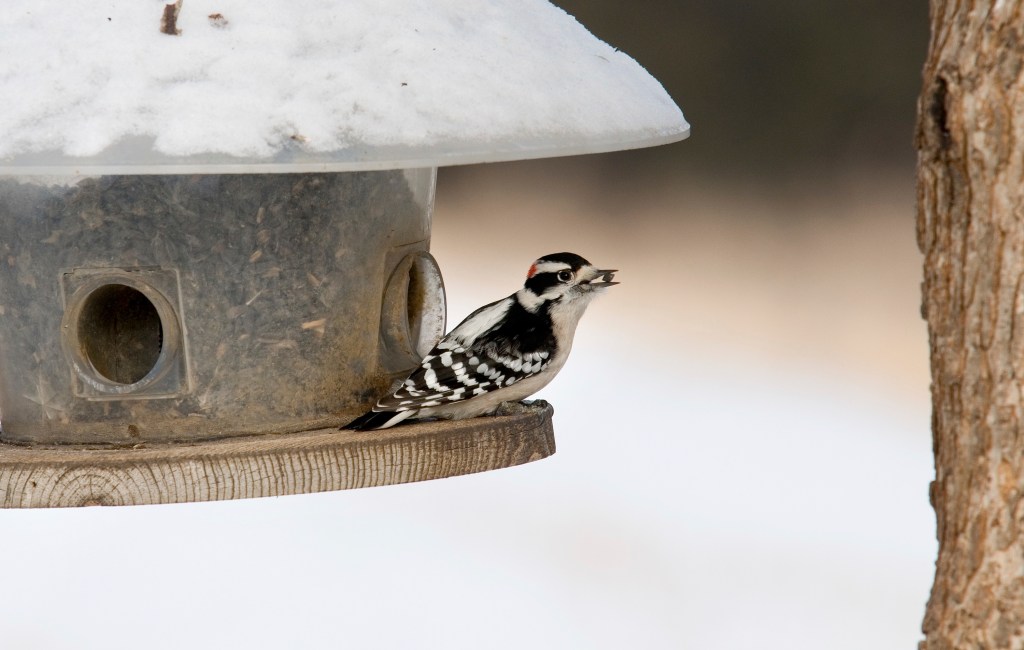Winter bird feeding is one of the most popular ways for people to interact with nature, and most do it to help birds get through these tough months. But what does this really mean for conservation? Does feeding help or hurt birds?
More than 40 percent of U.S. households feed their backyard birds, and in the United Kingdom, the rate is as high as 75 percent.
Despite the widespread popularity of bird feeding, scientists are still building a basic understanding of its impacts.
As we might guess, a number of studies show generally positive impacts of bird feeding. For example, the overwinter survival of birds is enhanced by bird feeding.
This is especially true during the coldest times, when some hungry birds might otherwise lose the battle with the elements1.
A study conducted during winter in Wisconsin showed that black-capped chickadees with access to bird seed had a much higher overwinter survival rate (69 percent) as compared to those without access to human-provided seed (37 percent survival).
Furthermore, some studies have shown that birds making it through the winter in better physical condition see those benefits carry over into the nesting season.
Bird feeding produces significantly earlier egg laying dates, larger clutches of eggs, higher chick weights and higher overall breeding success across a wide range of bird species2,6.

The greatest impact of feeding is seen when birds are most challenged, such as after particularly harsh winters, or when birds are young and inexperienced, or when they are living in low-quality habitats2. Feeding can promote the survival and reproduction of the not-quite-fittest.
But in contrast to these straightforward results – showing that bird feeding makes for better-off birds – a few studies indicate that, at least in some situations, there may be unintended consequences of bird feeding.
A European relative of the black-capped chickadee, the blue tit, was studied in the United Kingdom to examine the impact of bird feeding on nesting success.
One research group3,4 found that birds fed during winter subsequently laid a smaller number of eggs that had lower hatching success and ultimately fledged fewer young than birds that weren’t fed at all. The offspring that did fledge weighed less and had a lower survival rate than the young of unfed birds.
An additional U.K. study of the blue tit and another chickadee-like species, the great tit, had similar findings.
Both species, when they had access to bird food, laid fewer eggs, had lower hatching success, and ultimately had fewer chicks fledged.

Note, however, that these are just two studies demonstrating a negative effect of bird feeding – among a majority that show positive effects.
Nonetheless, the striking findings of lower reproductive success in supplementally fed birds need some explanation. Unfortunately, it was beyond the scope of these U.K. studies to definitively explain how bird feeding resulted in lower reproductive success, but the authors offer several possible hypotheses.
One possibility the authors suggest is that the bird feeding provided an irresistible diet that was unbalanced – too high in fat to produce high-quality eggs. More protein, micronutrients, and antioxidants than are provided by bird seed may be needed to produce high-quality eggs.
Another possibility is that bird feeding allowed individuals with a lower reproductive capacity which ordinarily would not survive the winter the chance to nest.
A final possibility is that the feeders were placed in poor quality nesting habitat – leading the birds to choose these suboptimal sites as nesting areas in the spring.
More research needs to be done across a wider geographic area and on more species to understand not only the impacts of bird feeding on reproductive success, but also on other factors such as disease transmission, species range expansion, and population trajectories.
Citizen scientists can help by participating in initiatives like Project FeederWatch that ask people with bird feeders to share their observations. What you see in your own backyard can contribute to the efforts to answer these questions.




I haven’t read the whole article, but am unclear why, if we are doubling the winter survival rate a lower birth and survival rate of chicks the following spring is seen as a negative. I’ve lived in the country a long time, and most populations have a self regulating mechanism. The prairie dog population increases so the foxes increase. Too many foxes and distemper appears. Foxes die off, the hare population increases (where my valley is in this cycle) then the raptor populations increases . . .and so it goes.
I’ve been feeding birds for many years. It gets very expensive, especially the Niger Thistle, which the Finches can’t seem to get enough of. I buy the Black Oil Sunflower Seed in 50# bags, it seems to be the overall favorite, however, there is a pretty big difference in quality, with the discount joints like Menards, Lowes, etc. selling the really cheap crap, seems you “get what you pay for”, with lots of damaged, and empty shells. It’s the same as with the 50# mixed bird seed which it loaded with corn filler rather than quality seeds. I’ve been feeding shelled peanuts, and peanut butter suet cakes, which the Woodpeckers love. I’ve noticed some of them getting rather obese, and wonder if it’s causing them harm?
We all want to support birds throughout the seasons and it seems… counterintuitive to argue that winter feeding is not helpful. It seems also disingenuous to propose this as a question, so that people who care about wildlife might worry that they are doing something wrong if they put birdseed out in the winter months. I don’t know if the goal is to drive web traffic, or actually inform better human behavior.
I found that when I supplied bird seed I had an abundance of jays move into my yard to build nests. When I witnessed a jay carrying a song bird chick towards its nest I began to question whether I was helping the corvid population or the songbird population. And I really didn’t care for the sound of a half dozen jay fledglings fighting over the feeder.
My yard was much more peaceful without the feeder the next year.
I agree about the jays. My first year feeding I had chickadees nest nearby. I attracted Steller’s and Scrub Jays and then their fledglings dominated the backyard and the chickadees haven’t nested nearby since. I switched to a jay proof feeder so the little birds can get in. The jays still show up to bully them, but leave soon afterwards since they can’t get at the food.
Wisconsin winter bird feeding is bound to differ from Louisiana winter bird feeding. One feed has to be better than another feed.
the birds seem to come to our feeders less when their is plenty to eat naturally. Could it perhaps be low quality bird seed, bird seed tainted with chemicals/ pesticides, or unclean feeders spreading disease or bacteria? Most people that put feeders out have no clue that the quality of seed matters and feeders need to be kept clean.
While this post focused on the benefits and detriments to the fed birds, I’ve also heard that there are impacts to the larger ecosystem as birds shift their diet from their “natural” food source and the seed we put out. Any thoughts?
PS: Just want to add:
To post this article, which is based on only two studies, each with small sample size, and each focused only on one species, is unnecessarily alarmist.
I’ve always thought that the feeding was fine while you were feeding but the problem comes when you stop – maybe due to vacation travel nor just losing interest. Then the dependent birds are left helpless.
One more way to feed birds is letting your native flowers go to seed so birds can eat them. Leaving berries on your shrubs (chokecherries for instance) also provides food into the fall and winter.
The question we should ask is where does the bird seed come from? Does it come from fields where birds are kept away so they don’t “steal” the seed? If it is so, then many birds suffer so that we can enjoy the sight of birds in our yards.
It seems that bird feeding does not help birds if we look at the larger picture.
It would be better to grow plants that benefit birds in our own backyards instead of bringing food from them from distant places. Let us have lo cavore birds!
The two studies you mention in your article were conducted in England. I rely on U.S. research done on birds of the U.S. and look to Cornell U. and other leaders in the field. It is important to know the cleanliness of the feeders, what food was provided in the feeders, what the habitat was like, etc. It is my understanding that most birds still get the majority of food on their own in the wild, even in winter, and that they rely on bird feeders, that humans provide, as a supplement.
I have read that a great deal of bird seed is chemically treated—that might be a factor, as well.
Yes, I stay away from seed treated with vitamins, etc. I don’t trust it and think it is overkill. However, we have no idea what kind of pesticides are on the seed we buy. It worries me a lot. I do plant flowers that make seed for them, too, but I’m pretty sure I couldn’t afford organic black oil sunflower seed even IF it was available here, which it is not.
Unfortunately, feeding birds is like welfare: It’s only necessary presently because of habitat (food) loss but creates an unnatural dependency on humans, as well as the listed potential side effects. With no habitat loss, winter feeding would be entirely unnecessary. How did birds survive the millennia before humans began feeding? Without the problem, there wouldn’t be the need for a solution. Create more habitat and we’ll help eliminate the problem.
I think the most blatant answer is the introduction of one of the world’s worst invasive species: the housecat. Without humans and their cats encroaching their territory, songbirds and other animals would have a significantly better chance of survival all year around.
I take exception to this comment. I feed anywhere from 10 to 20 ferals at my home in DC. I have never seen a dead bird. In fact the cats are freaked by the birds. BTW, as the cats join the colony I send them through a TNR program where they are spayed/neuterd and vaccinated for Rabies and FDV.
Pam:
Due respect — and I’m a big lover of cats — but the impact of both feral and domestic house cats on wild bird populations has been very well established and is beyond question at this point (I link you to an excellent NY Times article on this topic at the end of my reply…see below).
In fact, there have been NUMEROUS peer-reviewed scientific studies by PhD biologists and ecologists that have established without any doubt that both feral and domestic housecat populations have had a SIGNIFICANT effect on the populations of wild birds, rodents, and other wildlife. They are stealthy hunters, sometimes/often at NIGHT, so just because you haven’t personally observed one of the cats in your colonies hunting doesn’t mean it isn’t happening.
Here’s just ONE of the zillions of popular news articles that discuss this and make reference to the scientific studies:
http://www.nytimes.com/2013/01/30/science/that-cuddly-kitty-of-yours-is-a-killer.html
Regards,
Bill
Fairfax, VA
You do not see any dead birds because they eat what they kill or perhaps unlike most cats who have been known to leave presents ( fresh kills ) for their owners, your cats don’t particularly like you hmmmm.
We don’t have any cats, but I can tell you that the Broad Winged hawk and the Barred Owls take a fair share of birds each and every week . . .
I agree totally. Four cats moved in next door. We stopped feeding the birds altogether….darn it !!!!!
Penelope, Please comment with the research that backs up this claim. I am often hearing how house cats kill so many birds, but what I’ve experienced is them killing the slow, the weak, the disfigured among the bird population more often than the strong. Where is the research on how birds die from other causes? I learned that deer die worse deaths by not having a balance of predators in their environment.
One study showed that birds only got 25% at the most of their food from feeders.
I am a lover of birds. I am specialized in ecosystems biologist. I ask myself a question: for birds may be good to feed them in winter. But for the ecosystem ?. Balance is our goal, not some species. Thank You.
I so agree with this. I wonder if we artificially maintain high numbers of “tough guy” birds (House Sparrows, Blue Jays, Grackles, Cowbirds, etc.) by feeding them all winter, and then, in high numbers and in robust health, they go on to negatively impact our migratory birds.
I feed birds. During the summer, I get sparrows. In the winter – no sparrows. No blue jays eating in my yard during the winter. Golden finches, house finches, chickadees, and more. Juncos come in from the woods. They get food and water. Each area is so different. I will wait for more real data before changing my practices.
It would be hard at this point to determine what a natural balance really is, wouldn’t it? Humans have already so totally screwed up the natural balance.
Good point
I have had a bird feeder for many years. The last few years seemed to be more crowded with birds than before and then the gophers, ground squirrels and tree squirrels became over bearing hanging around the feeder all the time. So took down the feeder and cleaned up the area. Waited about a month and now about once a week widely broadcast a scoop of seed around the back yard. The birds are now distributed around the yard and continue hunting for natural food in the leaves and soil along with the broadcasted seeds. I have not noticed any problems with doing this at this time. And actually enjoy watching the birds even more than when they were all stacked up at the feeder. Also no more concentration of bird droppings.
Very smart idea. Hmmmm. Makes a lot of sense.
Thank you!
I am interested in how feeding birds may lead to faster local population growth that ‘nature’ then may try to balance. I learned about population growth and food supply from reading Daniel Quinn.
Thank you Joe! You mention the need for greater study of disease transmission, which reminded me of these tips on minimizing the risk of disease at feeders: http://www.nwhc.usgs.gov/publications/fact_sheets/coping_with_diseases_at_birdfeeders.jsp